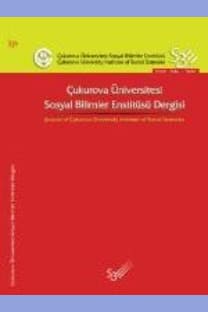MATHEMATICAL ANALYSIS OF TAX PAYMENT TYPES FOR CORPORATE TAXPAYER
Tax Evasion, Taxation and Revenue, Business Taxes
___
- Akbey, F. (2014). An inquisition on tax audits and revenues in Turkey. Dokuz Eylul University Journal of Economic and Administrative Sciences; 29(1): 63-103 Allingham, M.G. & Sandmo, A. (1972). Income tax evasion: A theoretical analysis, Journal of Public Economics; 1: 323-338 Alm, J., McClelland, G.H. & Schulze, W.D. (1992). Why do people pay taxes? Journal of Public Economics; 48(1): 21-38 Altundis, M. (2007). Tax crimes and penalties imposed in TPL and the effects of new Turkish criminal law on these crimes. Journal of Ankara Bar Association; 65(1):168-179 Fukofuka, P. (2013). The contextual framework of corporate income tax evasion. Journal of Accounting and Taxation; 5(2): 27-37 Hindriks, J. & Myles, G.D. (2006). Intermediate Public Economics, (2nd Ed.), The MIT Press, Massachusetts. Schneider, F., Raczkowski, K. & Mröz, B. (2015). Shadow economy and tax evasion in the EU. Journal of Money Laundering Control; 18(1): 34-51 Slemrod, J. & Yitzhaki, S. (2002). Tax avoidance, evasion and administration. Handbook of Public Economics, Volume 3, North Holland, Amsterdam Dhami, S. and al-Nowaihi, A. (2006). Why do people pay taxes? Prospect theory versus expected utility theory. https://www2.le.ac.uk, Access date: 18.08.2017 Istanbul Chamber of Certified Public Accountants (2016). The Draft TPL Evaluation Commission Report. http://archive.ismmmo.org.tr/Mansetler/MEVZUAT/Duyuru/VUK_TasariTaslakKomisyonRapor.pdf_431.pdf, Access date: 21.08.2016 Lipatov, V. (2005). Corporate tax evasion: The case for specialists. Munich Personal RePEc Archive, Paper No. 33998, https://mpra.ub.uni-muenchen.de/33998/, Access date: 19 August 2016 Tax Audit Committee (2016). 2012-2015 Activity Reports. http://www.vdk.gov.tr/default.aspx?nsw=dciSsil8zCRLPP9XnV0K5Q==-H7deC+LxBI8=&nm=1048, Access date: 10 August 2016 Tax Net (2016). Tax fraud crimes and penalties. http://www.verginet.net/dtt/2/359Kacakciliksuclarivecezalari_3197.aspx, Access date: 28 August 2016 Tax Inspectors Foundation (2016). An example for a limited company audited. http://www.vmv.org.tr/Yay%C4%B1n/10, Access date: 28.05.2016 Turkish Revenue Administration (2016a). The number of active corporate taxpayers. http://www.gib.gov.tr/fileadmin/user_upload/VI/20151.htm, Access date: 01 August 2016 Turkish Revenue Administration (2016b). Central government budget revenues. http://www.gib.gov.tr/fileadmin/user_upload/VI/GBG/Tablo_22.xls.htm, Access date: 08.08.2016 Turkish Revenue Administration (2007). Settlement in resolving tax disputes with the tax administration. www.gib.gov.tr/fileadmin/user_upload/yayinlar/uzlasma.pdf, Access date: 28.06.2016 Turkish Revenue Administration (2016c). Strategy Development Department 2011-2015 Activity Reports. http://www.gib.gov.tr/kurumsal/stratejik-yonetim/faaliyet-raporlari, Access date: 10.05.2016 Turkish Revenue Administration (2016d). Special irregularity fine. http://www.gib.gov.tr/node/83111, Access date: 28.08.2016 Yavaslar, F.B. (2015). Surcharges and penalties in tax law. Turkey’s national report. www.eatlp.org/uploads/public/2015/National%20report%20Turkey.pdf, Access date: 04.05.2016
- ISSN: 1304-8880
- Yayın Aralığı: 2
- Başlangıç: 2013
- Yayıncı: Çukurova Üniversitesi Sosyal Bilimler Enstitüsü Dergisi
Çiğdem KOŞAR TAŞ, Sibel ÖRK ÖZEL
Kalender Özcan ATILGAN, Talip İNCE, Sinan YILMAZ
Neslihan COŞKUN KARADAĞ, Ahmet İNNECİ
THE INTERRELATEDNESS OF CHARACTER AND NATURE IN KATHERINE MANSFIELD’S “PRELUDE”
İÇ MEKAN TASARIMINDA RENK ARMONİSİ
Ayten Pınar Bal, Ahmet Karacaoğlu
E-DEVLET SİSTEMİNE ADAPTASYONUN TEKNOLOJİ KABUL MODELİYLE ARAŞTIRILMASI
Serap Çabuk, Deniz Zeren, Nilüfer Gökdağlı
İNGİLİZCE EV ÖDEVLERİNE YÖNELİK ÖĞRETMEN GÖRÜŞLERİ
İşıl SÖNMEZ EKTEM, Sanem Büşra YILDIZ
